Know Your Leather
Leather is such a fascinating material. Every pore and scratch tells a story of the animal’s life. Since the dawn of time, mankind has been using leather for a variety of applications but one of the most common ones is shoemaking. In fact, different animals produce leathers with different qualities. This means there many types of shoe leather and it can get rather confusing and unclear for most of us.
You are lucky though. In this article you will find information about the most common “Types of Shoe Leather” along with some more exotic ones. As usual, it will be rather large! Get some coffee, use the table of contents to navigate and get ready to explore the amazing world of leatherworking.
Why Should You Care?
Apart from the construction of a shoe, the other most important aspect is the choice and quality of leather. Leather is essentially a hide sourced from different animals and has various characteristics. Each leather undergoes many steps to produce the end result. Some of them are perfect for rougher use and scuff resistant while others more delicate and for more formal occasions. Likewise, soft leathers like Suede don’t like water, but instead make for an excellent casual or summer shoe.
If you have at least a general understanding of the characteristics of most types of shoe leather, you will be able to make better and more accurate choices in the future. Not only that, you will learn a thing or two along the way!
The Oldest Shoe In The World
Did you know that the oldest shoe in the world is 5500 years old? Thousands of years ago, humans began using leather as a means to protect themselves from the natural elements. Our feet and hands help us keep a balanced temperature, but also lose heat first. It was imperative to cover those areas.
It was discovered back in 2010 during an excavation in Armenia and would be the equivalent of a woman’s US 7 in today’s sizes. A very primitive version of a wholecut from one single cowhide piece of leather and leather cords for laces. For more information check out National Geographic’s article on the subject.
Since then, shoes have definitely evolved and newer styles are considered classic these days. Just look at Chelsea Boots and Monk Straps for example. They all share one common characteristic however: the core style remains largely the same. There is not much evolution from a 100 year old Oxford shoe and today’s versions. In my opinion at least!
However, in this age of consumerism and fast fashion quality in mainstream shoes has waned a lot. This is why we try to educate people to invest in quality shoes that will last long and look great after many years.
Tip: This is about leather shoes, as some sandals are dated to be more than 7000 years old.
Grades Of Leather
As with most things in life leather has variations, or “grades”. The area that the leather comes from has also a big impact on quality, but that is a discussion for another time. Generally, the best leather comes from parts of the animal that are not exposed to damage so often. Typically, this includes the back while the worst parts come from the head and legs or belly. Stretch marks and imperfections are not the best right?
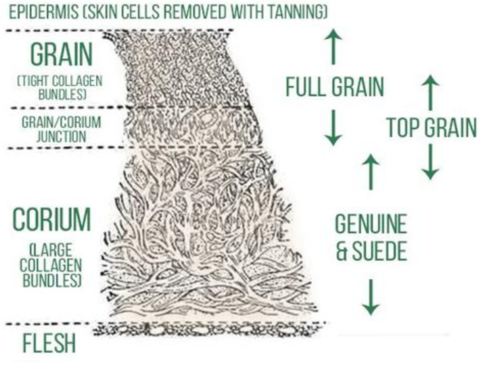
For now, here is a quick overview of the most common grades of leather so nobody can fool you anymore.
Disclaimer: You might notice that Suede is missing from this list, but that is because it deserves its own section later.
Full Grain Leather
Full Grain Leather is the best quality leather sitting at the top of the chain. It refers to the outside part of the animal’s hide just below the hair. The term “Full” means that it has not been buffed or sanded, which is a process that is used to remove imperfections or marks. The tight porous nature of the leather prevents moisture retention but it also means that it is thicker.
Thickness aside, only few parts of an animal hide are suitable for full grain leather which makes it more expensive and harder for leatherworkers to process. Nonetheless, full grain leather is a strong material that will develop a wonderful patina as it ages and last for years with proper care.
Top Grain Leather
Essentially, Top Grain Leather is like full grain but with a twist. It undergoes light sanding to shave off a few millimeters from the top, removing any imperfections.
This means that while it retains the general characteristics of full grain, it is thinner, less durable and more uniform. You could say that it is a more downgrade version that lacks the “Character” of the former. It does have a smooth finish and can take a stain better but is worse for breathability and patina.
The main problem with Top Grain is durability. Since it is thinner, it is not the optimal material for bags and shoes. These are items that you want to last right?
Corrected Grain/Genuine Leather
These days, everybody brands leather as “Genuine” and tries to pass it as high quality leather. In fact, it is the left-overs after using the top layers for better types of leather. The definition is quite unclear and it serves as a buzzword for uninformed consumers. Any type of hide from different animals can produce a leather item and be advertised as “Genuine“. This makes it increasingly confusing since Full Grain Leather is also Genuine. But then again, they wouldn’t need to advertise that.
To add to the insult, it goes through sanding and layers of artificial grain. This gives it a false natural look through spraying with stain and dyes. It is cheap to make and is your run of the mill, typical shoe in your local affordable shop.
Avoid.
Bonded Leather
If corrected grain is scraping the bottom of the barrel, bonded leather is the ungodly residue that remains UNDER that. It is not even leather, it is a byproduct. Just leftovers and scraps. Shred them, put them on a fiber sheet and spray tons of adhesives and polyurethane and voila. You have an unstable concoction of horrendous quality that will last as much as a cheddar slice in the sun. Oh, it also smells like the food they gave us in the army.
A mixture of leather and (mostly) plastic, bonded leather is unholy grail of the leather world.
Types Of Shoe Leather – From Popular To Exotic
The most common leather is calfskin by far. However, horses, goats and exotic animals are rising in popularity. Let’s go through them one by one! Remember to refill your coffee mug!
1. Calfskin
Calfskin is the most common material used to make high quality men’s shoes. As its name implies, it comes from the skin of young calves which are usually older than 3 months (and usually between 6-12). Another name for calfskin is “vellum” that derives from Latin. Interestingly, North American calves differ from European. The latter’s hide is typically twice as big and better quality due to breeding standards and use.
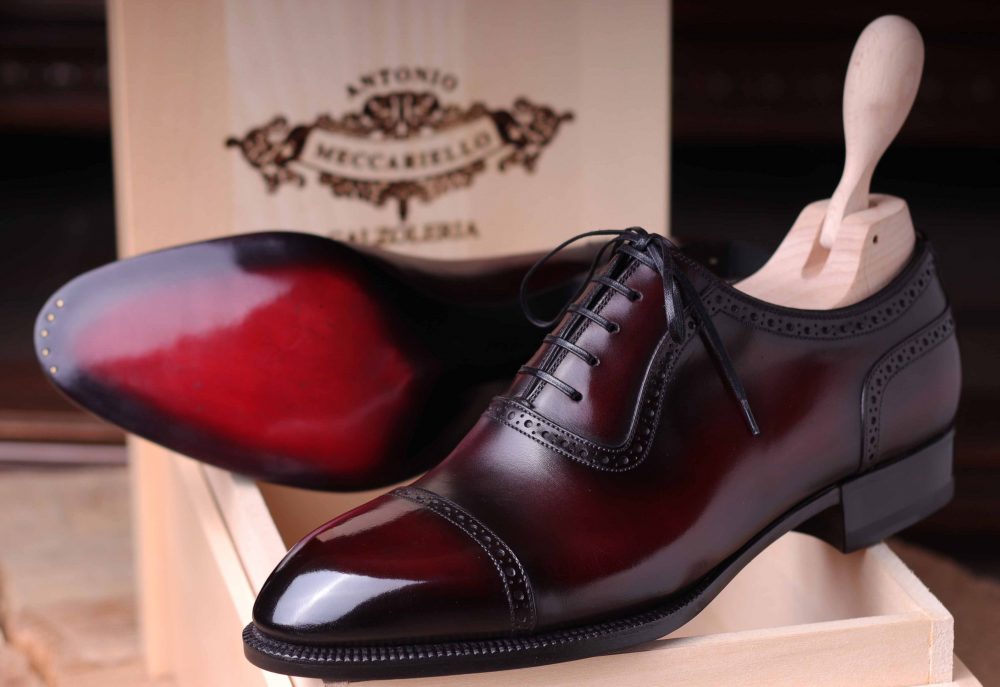
A leather of very tight grain and few imperfections, it is the perfect material for most higher-end dress shoes. The grain in particular is very fine but is quite durable and pliable. This is because calves have a dense fiber structure which is stronger than regular cowhide or older animals. Calfskin’s thickness tends to be around 1-1.2 millimeters and one good hide can provide enough leather for up to ten pairs of shoes depending on the model.
Although calfskin is prone to scuffing and scratching, using the proper polish and buffing can cover these marks (if not too deep) and develop an excellent patina in the future. It can take dye pretty easily so there are a lot of color options and finishes. Burnishing and aniline finishes help create a high shine. It also conforms to your feet very well which is important for comfort.
While it does not require heavy maintenance, it is important to polish and nourish it so it does not dry up or crack. If you want high quality formal shoes or need only one good pair, calfskin is a safe choice.
Update 05/06/2019: Once more thanks to Jesper from Shoegazing for a correction. One hide can produce up to 10 pairs (instead of the previous three) while bespoke/premium shoemakers 3-4.
1.1 Boxcalf
Boxcalf is a term that describes premium calfskin (or fine black calf) these days. However, the term comes from Joseph Box, who was a leather shoe craftsman in 1890. Luxury brand Hermès constructs their vintage bags from this premium material. In another description, it means that the calfskin is tanned with chrome salts. Therefore it can become very confusing and kind of a marketing word. In most commercial occasions I would say Boxcalf is high quality calfskin.
Tip: Actually, if you really want to learn about box calf, read this great input by Justin Fitzpatrick.
1.2 Veal
Veal is very similar to a calf, just a little bit older (three to six months). As with older animals the leather is a bit coarser and less smooth than regular calfskin.
Trivia: Calfskin was the substitute for paper before it became popular in the medieval ages.
2. Cowhide
There are not many core differences between calf and cowhide. They both come from the same animal, but cowhide comes from older cattle and is a byproduct of the meat industry. It is a reasonable comparison standard for other types of shoe leather.
More specifically, cowhide is thicker (about 1.6 to 2.5 millimeters) but goes through similar tanning processes as calfskin. The thickness, added strength and fibrous nature makes cowhide an excellent material for work boots or shoes for rougher use.
2.1 Apache
A very interesting type of cowhide is Apache. Also known as Distressed or Crazyhorse, this leather is treated with wax and oil to create a very vintage “old” look even when brand new. Waxing gives a more waterproof quality to the construction but also protects against scuffs. When you scuff these kinds of shoes, the waxy protective layer is the one that takes the hit first.
Apache cowhide can be lightly sanded or aniline tanned and this creates a very unique character. This leather is great for utility boots and outside use.
2.2 Bullhide
This is a thick bad boy coming from the shoulder of cows. It is very thick and sturdy so it will protect your feet much better against danger. Apparently, during tanning they shrink they hide quite often to put emphasis on the wrinkles and imperfections.
Tip: There is also retan bullhide that goes through double tanning for heavyweight use.
2.3 Deertanned
Deertanned leather is cowhide processed to offer the best qualities of cow and deer leather. Soft to the touch but with fewer imperfections or flaws, these type of cowhide is comfortable and a good material for boots.
3. Pigskin
Woohoo, now it’s getting interesting. While not so common in shoemaking, pigskin is a famous leather that has many uses. Some of these are high-end gloves and of course, footballs!
Pigskin usually comes from peccary, a type of mammal belonging to the pig family species. These are mostly common in South America and the most famous of them all come from Peru. It is worth noting that the peccary is a wild animal and does not live in farms. Hunting is therefore regulated by CITES along with many other hides.
So if it has other uses, why would you choose peccary leather for your shoes apart from the uniqueness?

Well, peccary leather is very thick but extremely soft and pliable. This makes it both hard-wearing, comfortable and flexible. Additionally, it is very hard to damage although they do require maintenance and seemingly do not like rain much. If you like a high shine though, this is not the leather for it due to the grain.
The exterior has a very distinguishable grain and texture, which I had the opportunity at witnessing first hand in the London Super Trunk. After you see and touch it for the first time, it becomes easy to identify peccary in the future. One very famous iteration is the peccary button boot by Enzo Bonafe, although through MTO.
Fashionable, not extremely expensive, soft and durable, peccary leather is great for casual shoes.
4. Suede
A few years ago, I never thought I would like Suede so much. It is slowly becoming one of my favorite types of shoe leather for casual shoes, including sneakers.
As you remove the hair and trim down the grain you get to the split-part of the hide, or simply the fleshy part. This fleshy part is sanded and buffed to create a soft thin texture with a unique nap. This makes it very easy to work with and is perfect for more informal footwear. Unfortunately, Suede is a sponge for water and stains making it quite a fragile leather.
Additional Info from Jesper Ingevaldsson: Most leathers called suede today are split suedes, then when it’s split to two or three pieces with one side where fibres are rugged. The “real” suede is today called reverse calf suede, there it’s a full hide with the flesh side rugged. If treated with impregnation sprays, it’s not sensitive at all.
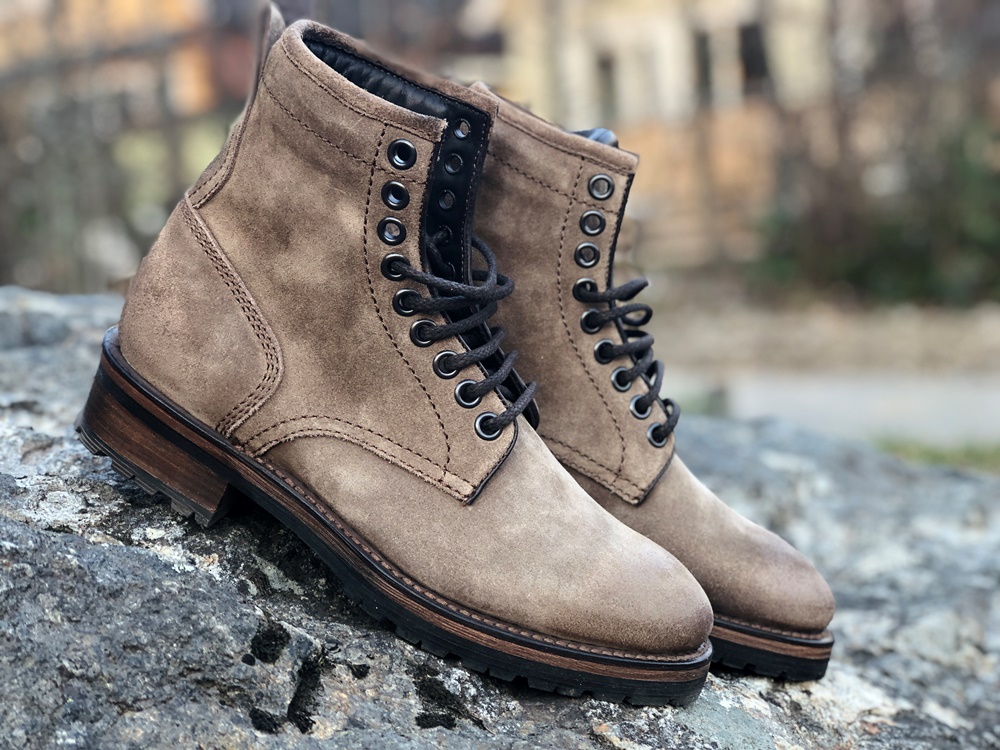
Suede comes from various animals and can have different qualities.
Trivia: The word suede comes from the word French “gants des suede“, which means Swedish glove.
4.1 Cowhide Suede
This is the fleshy part of cows and calves. It can get really confusing with names that include rawhide, split cowhide, bush coat and rough out. Save yourself the trouble and just call it cow suede.
Calves produce a softer suede than older cows just like with calfskin but as always, depending on the process it can be coarser or thicker.
4.2 Sheepskin Suede
Suede that comes from sheep is possibly the softest, especially if it comes from younger lambs. It is also very delicate and has a velvety texture. However, it seems to be much better at repelling cold and drizzles.
You might encounter this as kidskin suede, which is leather from young goats.
4.3 Pigskin Suede
Possibly the least popular of the three is pigskin suede. Coarser and tougher, it is a stiffer leather with a short nap. Compared to the others it is more durable and less prone to damage.
For a better comparison, pigskin suede is more lightweight and less thick than cowhide suede (1 to 1.5 oz, 0.4 to 1.6 mm vs 2 to 4 oz., 0.8 to 1.6 mm).
5. Chamois
Chamois (or Shammy Leather) is possibly the most confusing of the leathers here. Traditionally, it was made from the skin of the Rupicapra rupicapra, a European mountain goat. Today however it almost exclusively refers to the flesh part of sheepskin. Suede with other words. This is why it deserves its own section instead of including it above.

As usual, the process is to sand and buff the skin, removing the grain and revealing the flesh split. It remains soft (though not like traditional suede) with a thinner nap and is surprisingly water absorbent. More than often the cloths that you use to polish your shoes are from chamois.
Chamois is quite porous and goes through an extensive oil-tanning process. This means that it is quite hard-wearing and does not require shining. It makes a lovely pair of casual boots.
6. Nubuck
To complete the suede confusion trio, we have nubuck. Nubuck comes from cattle leather but the biggest difference with suede is that it comes from the grain part of the hide. It is sanded lightly to produce a similar soft nap, but coming from the grain means that it is much more resistance and water repellent.
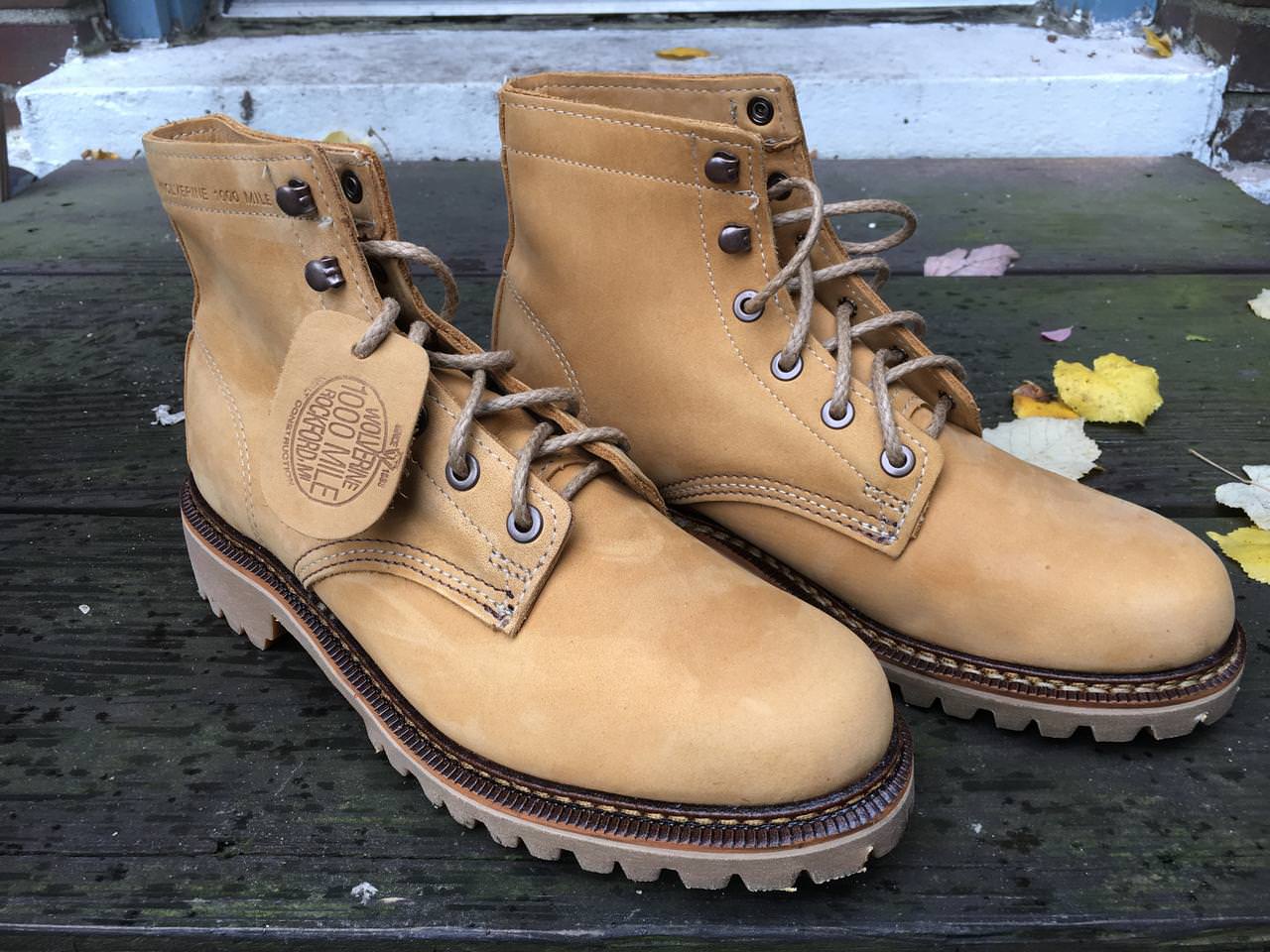
Therefore, it retains a lot from both worlds. The velvet texture of suede and the durability of top-grain leather.
7. Shell Cordovan
Shell Cordovan is the cream of the crop when it comes to luxurious quality shoe leather. Quite recently, I had my first experience using the Edward & James Rushton in Burgundy Shell.
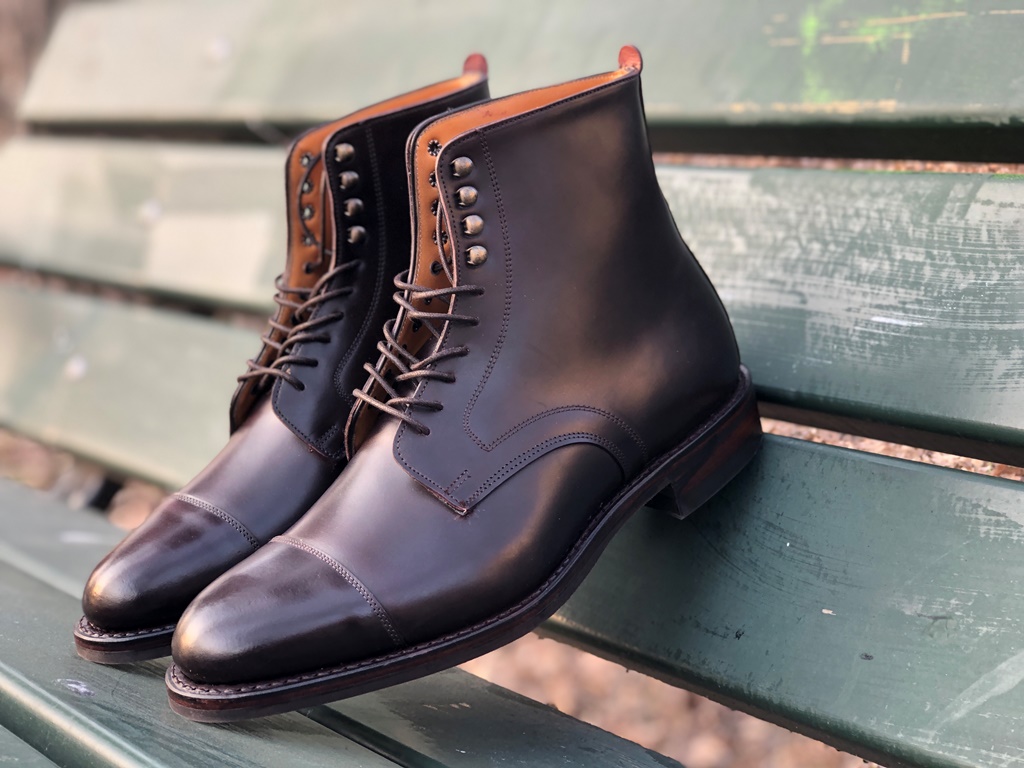
The most interesting thing about it is that it is not even a leather, not at least until after processing. Shell Cordovan is actually a very dense, fibrous membrane cut from the hind quarters of a horse. That’s right, one of the most expensive quality leather comes from horse butt. The name actually originates from the city of Cordoba in Spain.
7.1 What makes it so special then?
There are so many reasons! For starters, regular calfskin is porous, which you can see if you inspect it up close. It also creases with use, usually around the vamp. Shell on the other hand has no visible pores and instead of creasing, it ripples beautifully with time. Not only that, it is hard wearing, durable, generally water resistant and will last for decades with proper care. One of my favorite parts about it is how amazingly lustrous it is.
The problem with Shell is that each horse can provide a limited amount. It then goes through rigorous, long lasting (up to 6 months) vegetable tanning and multiple steps to be ready. Due to its nature, it is very difficult to dye and usually only accepts a handful of colors. The most famous of them all is burgundy, commonly referred to as “Color 8” which is a trademark by Horween. For those unaware, Horween is a widely acclaimed tannery.
These qualities make Shell very rare and expensive, but one cannot deny how beautiful cordovan shoes are. Appropriate for both boots and dress shoes, it is stylish and a statement. They develop a wonderful patina over time and I cannot wait to see how mine will look in a few years time.
7.2 Horsehide
Shell Cordovan is not the same as regular horsehide. Companies can often use the word “Cordovan” as a marketing buzzword but it is different. It often comes from the front parts of a horse and is elastic but also very tough. Horsehide is perfect for rugged, sturdy boots and while not as premium as its expensive counterpart, is still a viable great solution.
8. Pull-Up
In a way we already mentioned Pull-Up leather during our coverage of the Apache. You could say it is a kind of leather that is heavily waxed and oiled. The trick here is that when you pinch a spot on this leather, the color changes usually to a lighter tone. From my understanding, when you pull the leather the color migrates hence the change in color.
What this means is that Pull-Up is a bit like Ray Mercer’s jaw. Very durable. It requires little maintenance and will develop a rich patina. While it can take punishment and absorb scratches, it is not scuff proof. Great for casual boots and appear to be very popular in North America.
Tip: Do not confuse Pull-Up leather with the synthetic PU leather.
8.1 Chromexcel
The original pull-up is Horween’s Chromexcel (CXL). It is very popular across the Atlantic since its introduction in the 1920s. The most common source is horses but you can also use cowhide. Vegetable retanning and 89 separate stages of preparation means this requires meticulous, hard work to produce.
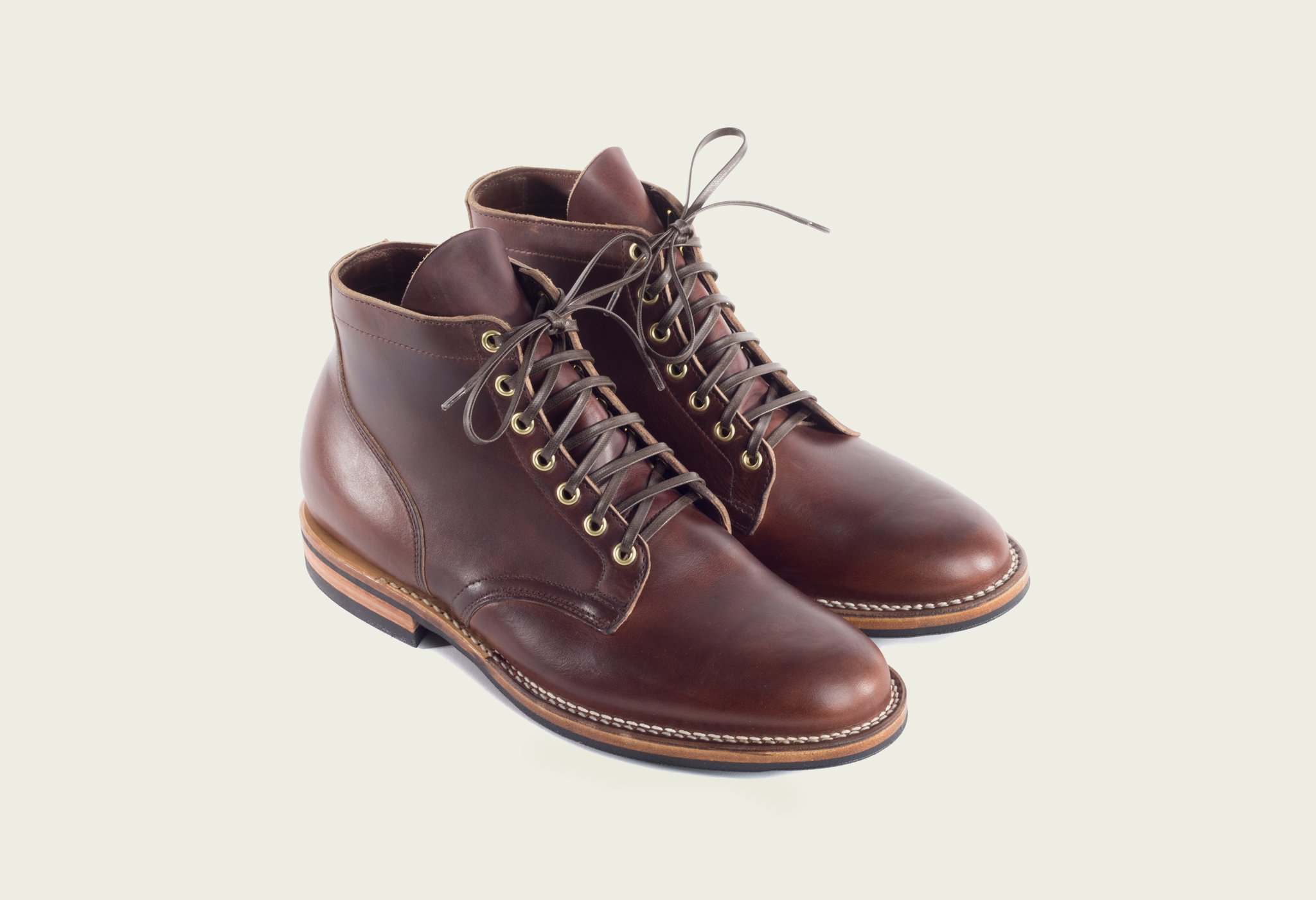
With a great reputation for suppleness and foot conformity, Chromexcel will remain a fan favorite for years to come. Instead of babbling about it, I advise you to read this excellent entry by Horween themselves.
9. Rough-Out
Another very interesting type of shoe leather is Rough-out (even Rough-out Suede). It is fascinating how much variety exists in one leather family. It uses the rough flesh side of the hide on the outside, while the grain part remains underneath.

The fleshy part is quite rough, which gives it the name “Rough-Out“. Usually from cowhide, it is soft with a nice nap and requires little to no maintenance. As the name implies, it is very durable and a fan favorite during the older war times and mountaineering as work boots due to the low upkeep. Durability comes from the fact that the tough grain is intact but it can absorb more water than usual.
Update 2021: Roughout Suede often goes as Reverse Suede and it can have a very short non-existent nap when waxed. It is also very durable with a rustic look and perfect for casual winter wear. A famous example is the Crockett & Jones Molton.

10. Scotch Grain
Originating from Scotland (what a surprise!), Scotch Grain is leather with an added embossed texture. It has a very distinct texture that resembles pebbles and all the work happens in the tannery. This is why Pebble Grain is another name for Scotch Grain.
Rumor has it that the Scots developed this ages ago, shrinking the leather to create these patterns. The result: A low maintenance, durable and weather resistant type of shoe leather. Certainly less formal than its smooth calf counterparts, Scotch Grain is increasing in popularity these days and is duly represented by the abundance of classic British Country Shoes.
Since the texture is artificial, this kind of leather tends to be a little thicker while it is much easier to hide imperfections or scratches. Just light polishing is required, since too much can build up excess wax and white residues inside the pebbles.
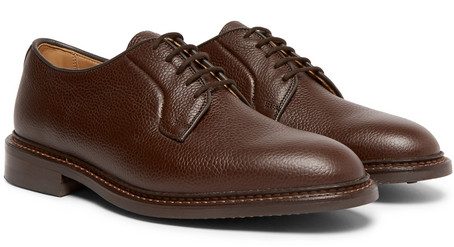
Generally speaking, the term Pebble Grain is used to include all types in this category. However, there are some minor differences such as Pin Grain and Russian Hatch Grain. The former has a smaller pattern while the latter probably needs analysis of its own. Check out the official entry from Crockett & Jones.
11. Vegetable Tanned Leather
A raw hide is not great. It is stiff and putrefaction (decay and decomposition) presents a real problem. Smoke, alum and oils were some of the options, but vegetable tanning was the most reliant and durable of them all. My ancestors in Ancient Greece and Rome were the pioneers of vegetable tanning and it was for a long time a pillar of society.
It is a long process that uses tannins from various parts of trees such as bark, wood and leaves. The leather retains its natural color which will darken up with time. As mentioned, it is a lengthy expensive process where the hide sits soaked that requires multiple treatments.
Organic, a little stiffer and with a wonderful patina, vegetable tanned products do not like water very much and come in limited colors. After a decline in popularity due to the cost and the introduction of rubber, high quality leather goods mean vegetable tanning is back in the spotlight.

12. Patent Leather
Remember those shoes you saw the other day with that very high glossy shine. Introduced in the early 19th Century, Patent Leather is the only formal option for Black Tie events (apart from maybe velvet). This is why you will most likely see it only in black, to match your Tuxedo.

The process comes from Japan and uses a complex lacquering method that smooths the exterior and give that high gloss finish. Unfortunately, this has been largely replaced by plastics that mirror the effect. Unless you need formal evening wear, you should not worry about Patent Leather.
13. Buffalo Leather
Buffalo, Bison or Water Buffalo is an interchangeable term these days. Some hides come from Africa while others from the US and Asia. It is a good, durable choice for long-lasting items such as bags or boots.
It is porous and grainy with natural imperfections and boasts an impressive 40% more tensile strength than traditional calf. Additionally, it is quite comfortable and rather soft.

14. PU Leather
The last of the bunch of the normal types of shoe leather is PU. Not to be confused with Pull Up, PU Leather is one of the few choices for vegans. This means it is not really “leather” per se, but instead bonded leather or purely synthetic material like polyurethane.
Of course, this is very low quality and should not be on your list unless you are very strict about not exploiting animals. Otherwise, there is no excuse to buy a shoe from PU Leather. Low on budget? Go on eBay and buy a used good shoe for a few dollars.
Exotic & Unusual Leathers
Now it is time to get to the good stuff. Man will make shoes out of anything. Sometimes because of the characteristics, others due to the aesthetics and sometimes…well just because he can. Doing my research and compiling this guide, I was so surprised with some of the entries.
Refill your coffee.
15. Alligator & Crocodile Leather
To save multiple confusing entries, we will talk about these fearsome reptiles here. Possibly the closest thing to the dinosaur era, alligators and crocodiles are often synonymous with luxury lifestyle and a deep pocket.It is very important to note that Alligators and Crocodiles are different species. However, they are under the same family. There are 4 main species that produce different types of shoe leather these days:
- American Alligator
- Caiman
- Freshwater Crocodile
- Saltwater Crocodile
Each has its own characteristics and they are hard to differentiate. They generally are strong and durable, but also very hard to stretch. Leathers come from the belly area which is quite soft and the top which is protected by an armor plate of scales. Both Alligator and Crocodile leather is very expensive but the former is considered much more premium. They also have a high sheen and if cared properly will last for decades.
Trivia: Crocodile noses have a pointy V-Shape while Alligators have a wider nose with a U-Shape. Dinosaur fan? Google Sarchosuchus.
15.1 The American Alligator
The big daddy of luxury reptilian leathers. Weighting almost half a ton and up to 4-5 meters long, the American Alligator produces top quality leather for dressier shoes. Their leather is sources from special farms especially in the Southeast USA.
Their leather is very durable but also soft since it is not so bony as the other reptilian counterparts. Often comes in grey and olive green colors but is available in much more. Softer leather means it is much easier to process and work with, thus making it better to make shoes and bags.
Alligator leather is so premium and commands the highest prices in the fashion industry. It has a very high sheen and very distinct rectangular scale pattern that is not uniform. The umbilical scar is also a way to recognize real alligator skin from fake reproductions, since it cannot be replicated.
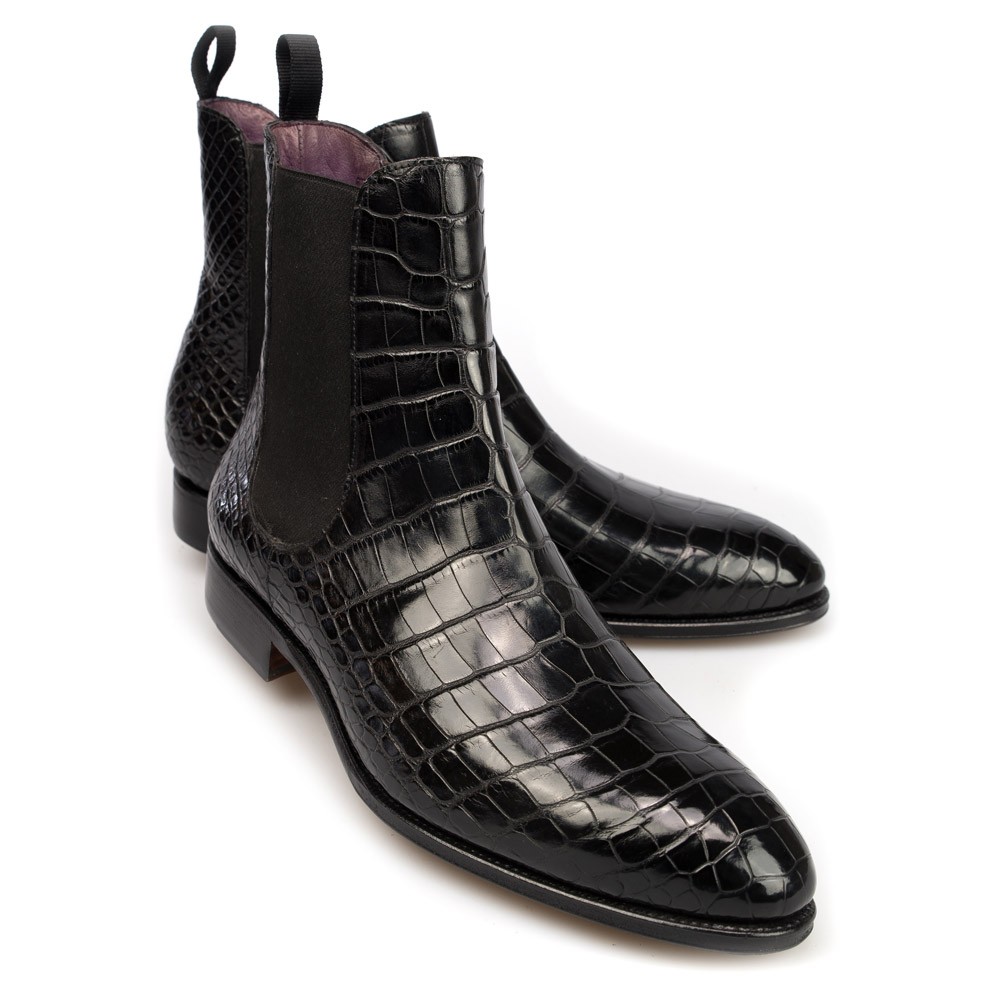
You will find them both in regular dress shoes or boots and easily command prices of over 3000$. Carmina makes some nice options if you have such a budget available. They are a big statement though, be ready for it.
15.2 The Caiman
Present in Central and South America, the caiman is a smaller cousin to the alligator. A famous species that donates its name to both the Porsche Cayman and the Cayman Islands, the Caiman has many different properties.
For starters, their size means that each hide is substantially smaller and more hides are required per item. However, they are readily available and for a much smaller cost than crocodile and alligator leather. Regardless, they do cost more than regular calf.
The biggest problem with Caiman Leather is that it is very bony compared to all other reptiles. Therefore, it is very stiff and hard to work with. The bony nature of the hide however is excellent for someone that wants to showcase the natural pattern in a pair of shoes. Calcium deposits in the ridges of each scale create this pattern effect and can take color very well.
15.3 The Saltwater/Freshwater Crocodile
While these are distinct species, I am not an expert on crocodilia. I do know though that the Saltwater crocodile often comes from the Indopacific and Australia and is the stuff of nightmares. We are talking about some monster sizes! The Freshwater counterpart however comes from Africa with the Nile crocodile being the largest freshwater predator in the region.
16. Anteater
No, you did not read wrong. The Anteater is a mammal with a long snout that feeds on ants and termites. It is an exotic, rare leather with unique properties. Very durable and scaly in the forms of tiles that have a diamond shape which is different from alligator leather.
Since this is an endangered species, hunting has to be strictly regulated and most hides come from Asia or Africa. Colors include brown, cherry, black and beige.
It is a very uncommon, unique type of shoe leather and mostly used to make cowboy boots.
17. Camel Leather
Now, I am not sure why you would want to make shoes out of a Camel. The animal first needs to die from natural causes and is mostly present in Africa and some parts of Asia. An important part of everyday life in those areas, Camels are valuable to the locals!
The leather is scuff and scratch resistance with a little bit of texture, however it is often sueded to soften it up. It can be quite soft and resistant and you will mostly see it in coats. The rarity means that Pure Camel shoes are extremely scarce and chances are you will never see any.
Interestingly, Camel Leather has 10 times more fibers per square centimeter than cow hide. You encounter Camels usually in desert extreme climates and this is important for their protection. As for colors, tan, caramel and desert orange seem to be the natural options.
Finding a proper picture is a challenge, but here is an example of what looks to be Camel Leather Shoes.

18. Chicken Leather
We live in an age where genuine chicken leather is considered an exotic skin. Chickens are abundant all over the world, but you must admit it is not the first animal that spurs to mind for leather goods, let alone shoes.
Apparently, Chicken leather is durable and versatile with a nice texture to it. The texture is the part that qualifies it more as exotic. Some very luxurious items use this leather actually!
When it comes to shoes, it needs frequent and proper conditioning. This allows it to remain soft and not crack or brittle. With no natural oils to protect the dead skin, moisturizers are vital to prevent damage. Leather honey seems to be a good and effective solution.
Unfortunately I could not find any pictures of shoes, just bags and accessories. Here is how the hide looks like though.

19. Deerskin
The term “Deer” includes a lot of animals in the same family. It includes from Caribus, to elks and moose to name a few.
Generally, Deer Leather is very soft. Some say it is one of the softest leathers around with great conformity to your feet and hands. Additionally, the skin is pliable and prone to scratching and tearing which makes it unpopular with many shoemakers. Very interesting from a wild animal living in forest areas with dangerous environments everywhere.
Elks in particular have a reputation of extreme softness. This leather is also breathable and thin which means your feet will not sweat as much. However, it does not like rain or water and you should definitely waterproof your shoes.

20. Eel Leather
Eels are elongated slick fish of various sizes. People eat them, but also make leather goods out of them.
Most Eel skins come from Asia and more specifically the Philippines and Korea. It has no scales and seems to be very thin and fragile. Due to how thin and relatively small the fish is, multiple skins have to be used to create shoes.
A unique pattern of strips is visible on the vamp, but I personally find hideous all the designs I see out there. Don’t forget that this is a fish, so the leather needs moisturizing and conditioning.
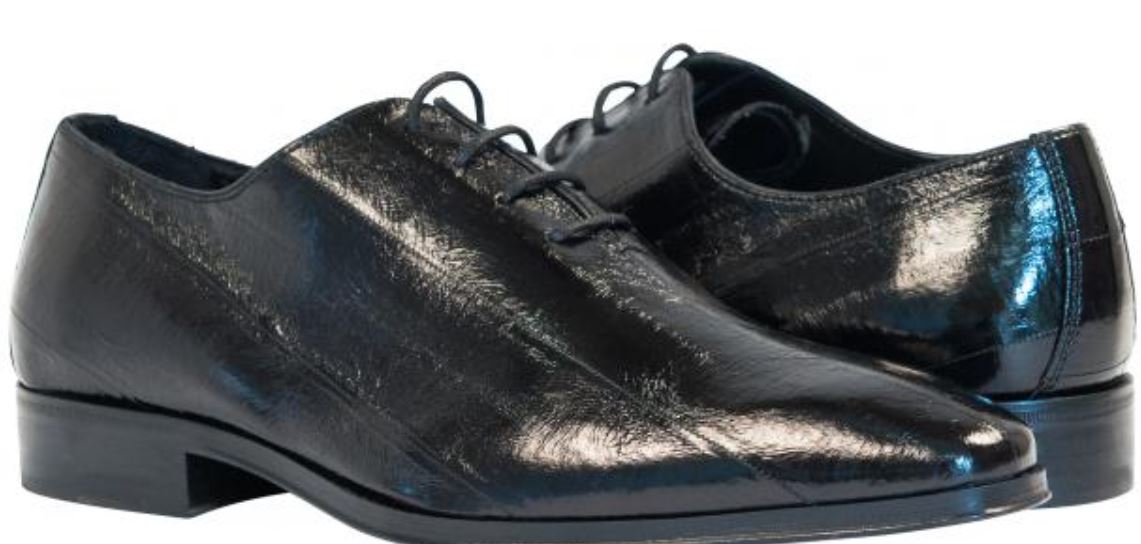
21. Elephant Leather
When I was at Chopin Airport in Poland, I saw a little glass vitrine that caught my eye. Inside, there was a whole elephant foot that someone tried to smuggle. Right next to a polar bear hide, tiger and whole snakes in a jar.
Poor elephants are illegally poached for their tusks and although rarely, their hides. While regulated, it is possible to find legal elephant leather for making shoes and bags. All hail our environmentalist lord Jay Z for ordering a pair of elephant sneakers.
It is a massive animal and it really shows in the properties of its leather. It is incredibly scuff and scratch resistant with a very dull color. The pattern and feel is very unique and looks like parts of triangle and square grooves into the skin.
Elephant skin has a crackled, dullish, hard finish and is one of the most durable and scuff resistant skins. Elephant skin boots are much more comfortable and breathable than sharkskin boots although having superior scuff resistance.
I had the chance to see and touch one first hand in the 2018 Stockholm Trunk Show.

22. Giant Bass
No, it is not a giant instrument. This is a massive fish with proper scales and a huge pattern.
I don’t have much information on this one. I just know they use it for cowboy boots and the most famous maker is Anderson Bean. They look absolutely ridiculous.

23. Giraffe Leather
The tallest land mammal on the planet needs no introduction. One will encounter Giraffes mostly in Africa, where most of the hides come from. However it is an extremely rare leather that can only be procured after the animal dies of natural causes. Additionally you need a special permit to import the hide which makes it very costly.
The coating is the most important part of Giraffe skin and it is not sanded out. It has trapezoid patterns with a white background and a medium soft touch and grain to it.
Long lasting and quite stiff, probably not for those with foot problems. Honestly, let me rephrase that. No gentleman should wear these kinds of things (unless maybe you are an artist?). I could not find a picture worthy showing.
24. Hippopotamus Leather
Quite a new player in the shoe game, hippo leather comes from a strong and fearsome animal. Battle scared in the wild with a strong grainy texture, Hippo Leather is sanded to smooth out the finish.
Apparently it is also super soft while at the same time comfortable and strong. Usually the end product of MTO’s, you can choose if you want a more suede velvet finish or a smoother calf-like appearance.

25. Kangaroo Leather
Even though Kangaroos have a large population in Australia, it is not a leather you see as often as calf for men’s dress shoes. Regardless, it is very popular for durable footwear in the athletic industry due to its properties.
Strong, soft and with minimum break-in period, Kangaroo leather is one of the most comfortable leathers around. It has a lot of qualities that make it better than calfskin. For starters, it has 10 times the tensile strength of calf and 50% more than goatskin. Additionally, it is light with a very tight fiber concentration but it is still prone to scratches.
The fibers of Kangaroo leather interlock as opposed to regular calf which is in horizontal layers. An absolute champ, it is the pound for pound king of leathers when it comes to durability. Very easy to recognize from the natural scars on the vamp.
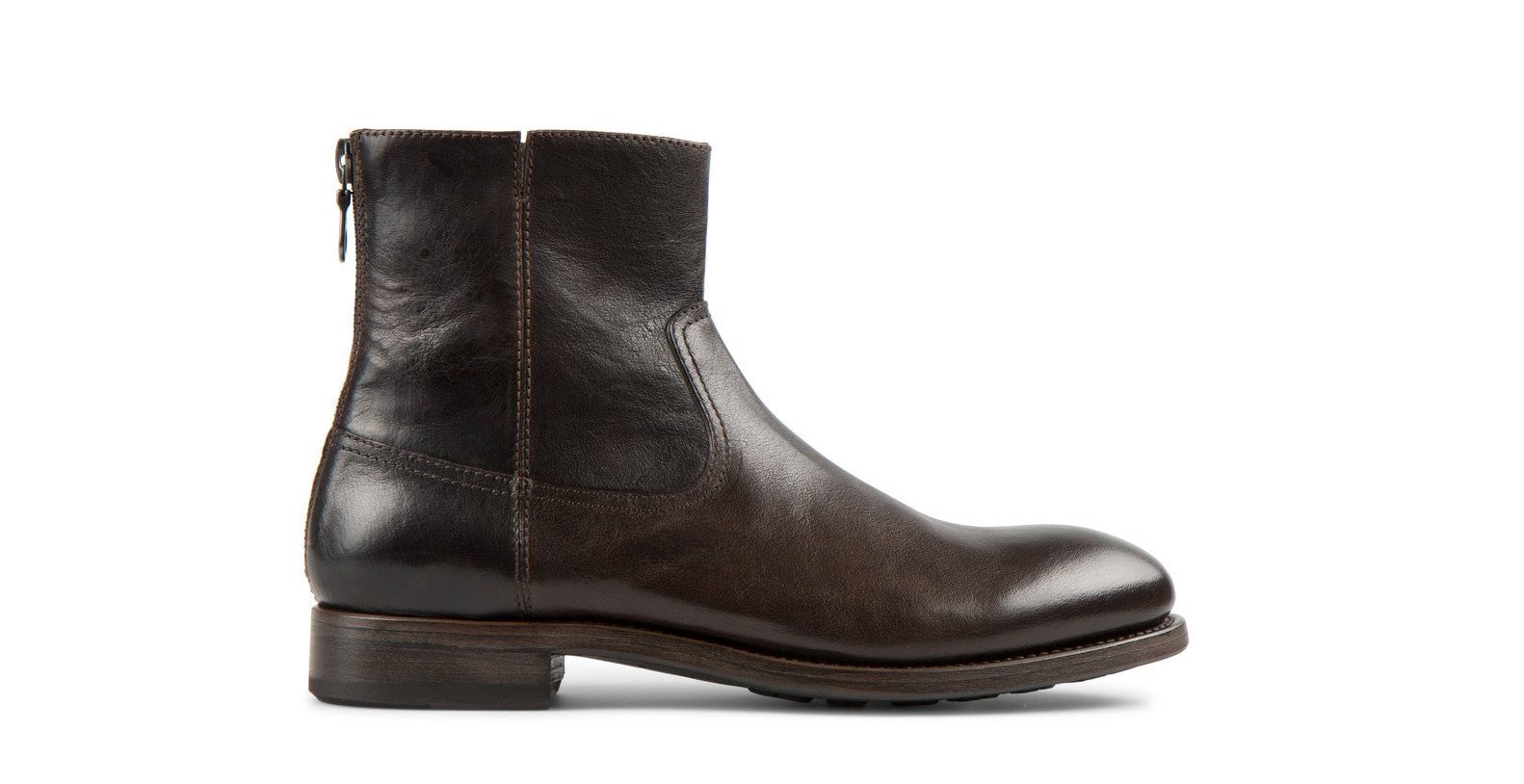
My recommendation is to avoid them as work boots and rather buy one if you look for comfortable casual shoes.
26. Kudu
Kudu is a fascinating leather that comes usually from African Antelopes.
A fantastic material for tougher boots due to its looks and rugged properties. These are wild animals that run around, have scratches and graze bushes and thorns that impact the skin. This creates a very distinct pattern on the hide with a light grain and medium weight. Every hide will be different because of this.

Sueded Kudu on the other hand is extremely smooth and blemish free. Tricker’s and Viberg make some very famous Kudu boots and it is something I want to try in the future.
Tip: Impala is another wild animal with similar properties.
26.1 Horween Kudu
A small section, but a very important one nonetheless. Horween produces a special color of Chromexcel leather with the codename “Alden Kudu”.
Therefore be careful to distinguish between the two when you look for Giant Kudu leather products.
27. Lizard Leather
A broad category that involves a few different kinds. Famous lizard leather comes from Iguanas, Tejus and the giant Komodo Dragons.
The hides typically come from the belly of the animal and have a small tile-shaped pattern. Lizard leather also has a nice sheen and uniformity and can take color rather well. Some use the back of the skin (hornedback) and overall make fashion statement boots.
The advantage of Lizard leather is that it looks a bit like crocodile and alligator but costs much less.

28. Ostrich Leather
Come on, who doesn’t know what an ostrich is. Did you know though that it can produce meat, giant eggs and of course shoes?
Super strong due to its fiber structure (crossed instead of parallel), Ostrich leather is possibly the most recognizable type of shoe leather. This is due to the visible “bumps” on the surface of the leather.
It has all the best qualities you could ask for. Soft, supple, durable and tough, rot and scuff resistant while at the same time resistant to cracking and dryness. What more could you ask for? It is however rather expensive and makes excellent boots. Careful as it will not stretch too much.
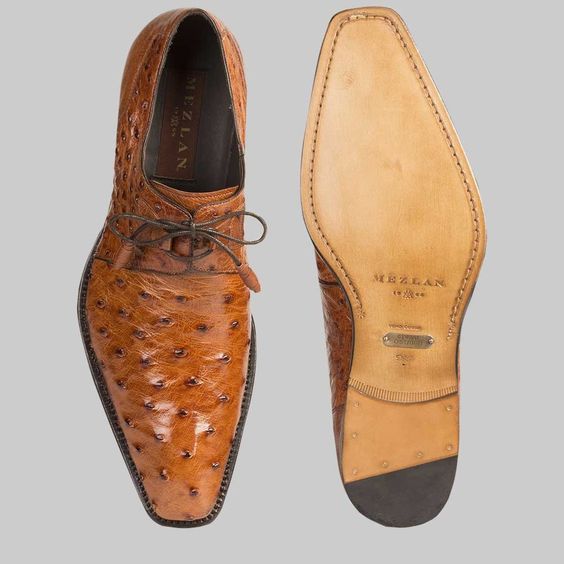
Trivia: The size and frequency depends on the area the leather comes from and depends on the age of the ostrich. The most luxurious part is over the foot.
29. Sharkskin
Rumor says Sharkskin is the toughest, most abrasion and scratch resistant leather of them all. A leather with a very unique grain that varies from the shark it comes from. Some skins are stiffer than others but the general consensus is that Sharkskin is hard to break in and not optimal for hotter weather.
On the surface you will see some kinds of “raised” sections which receive the dye in different ways. Lighter on the top than the bottom, it creates a mottled effect with a linear grain. Sharkskin has incredible tensile strength with long fiber structures and makes excellent work boots.

Moisturize, condition and clean it often and it will last for a lifetime. Beware that it is very costly.
30. Snake Leather
Another convoluted category is snakes. It comprises of multiple species but the most common ones are python, rattlesnake and anaconda.
Python is popular and the most durable with a unique scale pattern and color. You can dye it in multiple colors but natural snakeskin tends to be a mix of white, black and brown. Depending on where you cut the leather from it has different characteristics. An example is cutting from the back or the belly of the snake. On rattlesnakes the latter method is often preferred to showcase the diamond pattern of the skin.
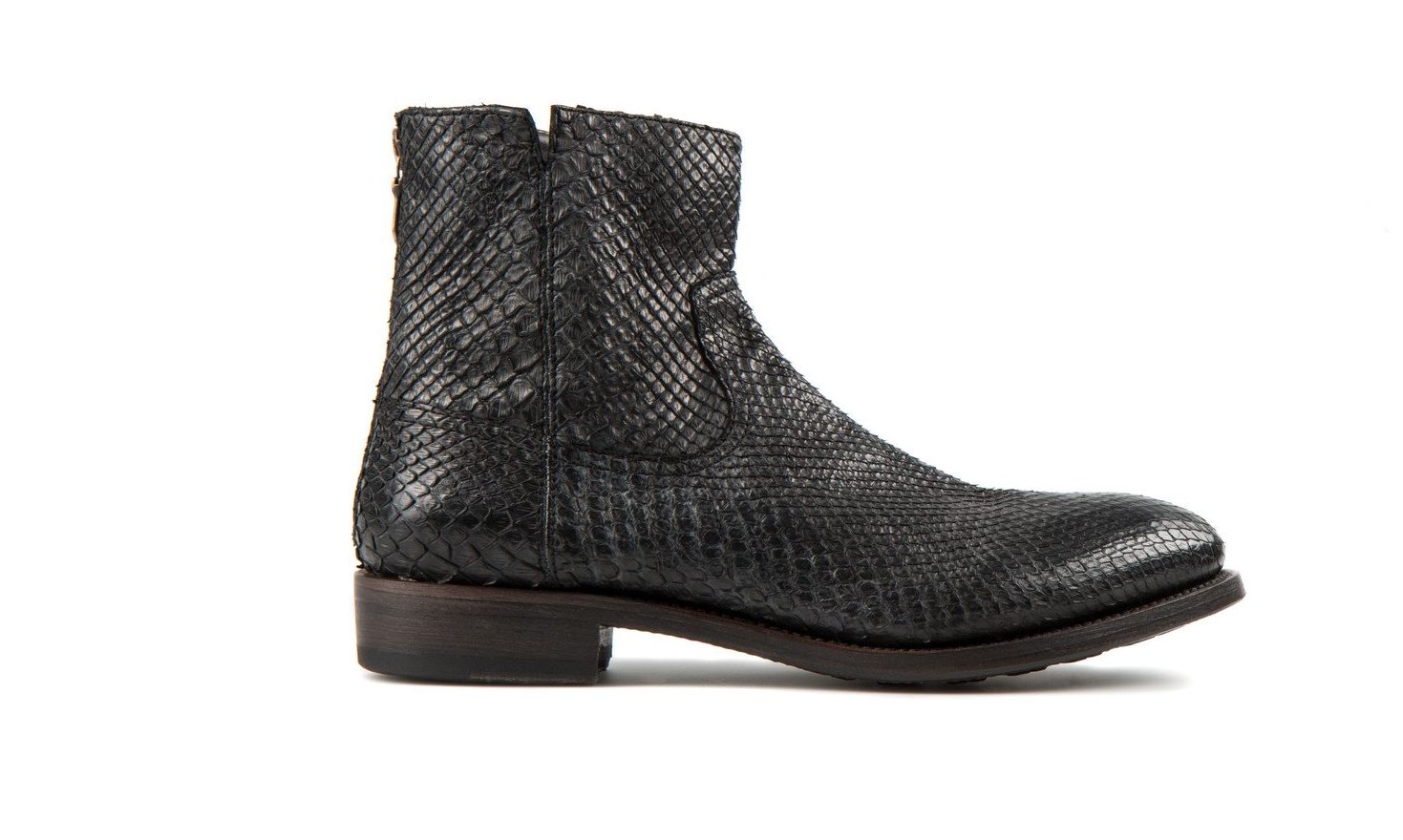
Mostly prominent in women’s shoes, snakeskin has crawled its way (pun intended) to the men’s fashion world too. Quite comfortable and soft, snakeskin is commercially farmed. Still, it is a very big fashion statement but always good to be aware of.
31. Stingray Leather
One of the toughest leathers of them all, the Stingray is a majestic fish with a very recognizable shape.
Available in multiple colors with an amazing texture feel, Stingray leather is premium and rare. Mostly used on accessories and small items it is also an option for making shoes, although mostly MTO. Texture wise, it looks like marbles or small tiny pebbles and has a distinctive “star” shape like an opal in the middle of the vamp.
It is incredibly tough and hard and will not stretch so you should be absolutely sure it fits. Not the shoemaker’s favorite leather though as it is so strong it can break needles. This means it is scratch resistant and since the stingray is a sea creature, water resistant. If you are one of those people that always end up scuffing their shoes, you might as well invest in Stingray!
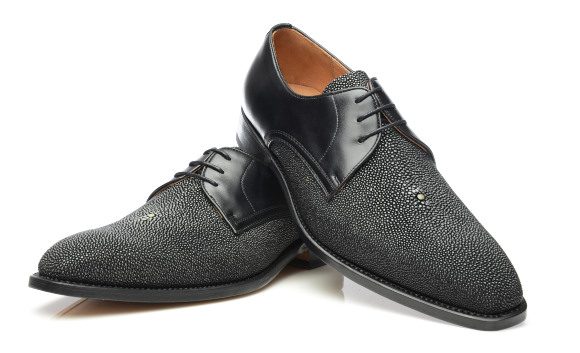
Frequent conditioning is required, but it is quite stylish I would say compared to the most exotic alternatives.
32. Toad Leather
The Cane Toad is one of Australia’s most unpopular animals. The reason for that is that it is a major environmental pest whose population must be controlled. These days humans use the skin of the Cane Toad to make different leather goods ranging from bags to jackets and shoes.
Cane Toad leather is durable and strong with unique properties and comes in a variety of finishes. The lining is from pigskin and the poisonous sacks are very distinctive as you see in the picture. A shoemaker needs more than six hides to make a pair of shoes, which makes it very expensive.

Trivia: Prince Charles received a Cane Toad leather book from the Premier of Queensland.
Types Of Shoe Leather – Something For Everyone
We are finally at the end! If you made it that far, good job! You deserve a gentleman’s cookie. As you see, the list is very large. In fact, during my research I found many other leathers mostly in the exotic category such as zebra and salmon skin.
The lesson from this article is that every leather has unique properties and appearance. Some are better for comfort, while others better for durability or softness. For the ordinary everyday gentleman, calfskin and suede is the best option. Shell Cordovan on the other hand is for an enthusiast. These will accompany you in your everyday meetings, walks and ventures and never fail you. Your core wardrobe should consist of shoes from the main category.
The Exotic Conundrum
Most of the leathers in the luxury exotic category usually cater to the extravagant persona or someone that really wants to stand out. Additionally, the are loud and not the first choice for a businessman, especially if you work in a more conservative workplace. Would you wear alligator shoes if you were an medium position IT or Engineer person? It makes no sense.
There are a few however that don’t break the bank, are more subtle and great for everyday use. Deer and Kangaroo are probably your best bet due to softness and foot conformity. My advice is to browse through these categories and stick with the ones that resemble calf for your first 10 pairs.
Concluding Remarks
I learned so much! I hope you did too! The world of leather and shoes is incredible and full of surprises. This is a very large guide and you do not have to finish it in one sitting. You can always come back to it and refresh your memory or simply look at some of the gorgeous designs.
If you like it, please bookmark it and share it with someone who will appreciate it. Subscribe for more awesome shoe content and remember to check out our first Bespoke Interview. Stay sharp gentlemen!
Thank you for reading,
Kostas Mandilaris,
Misiu Academy


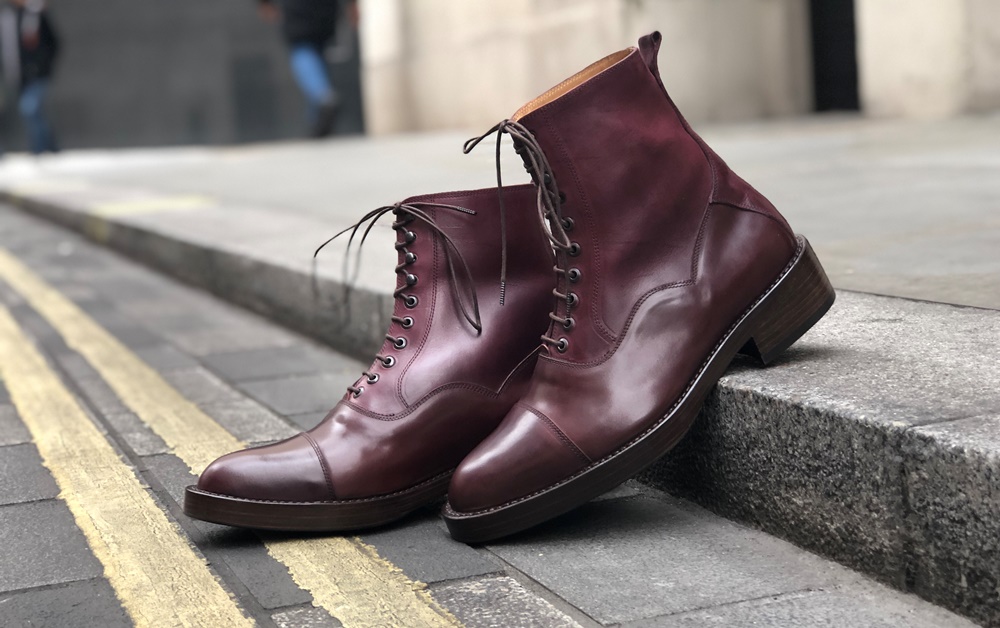
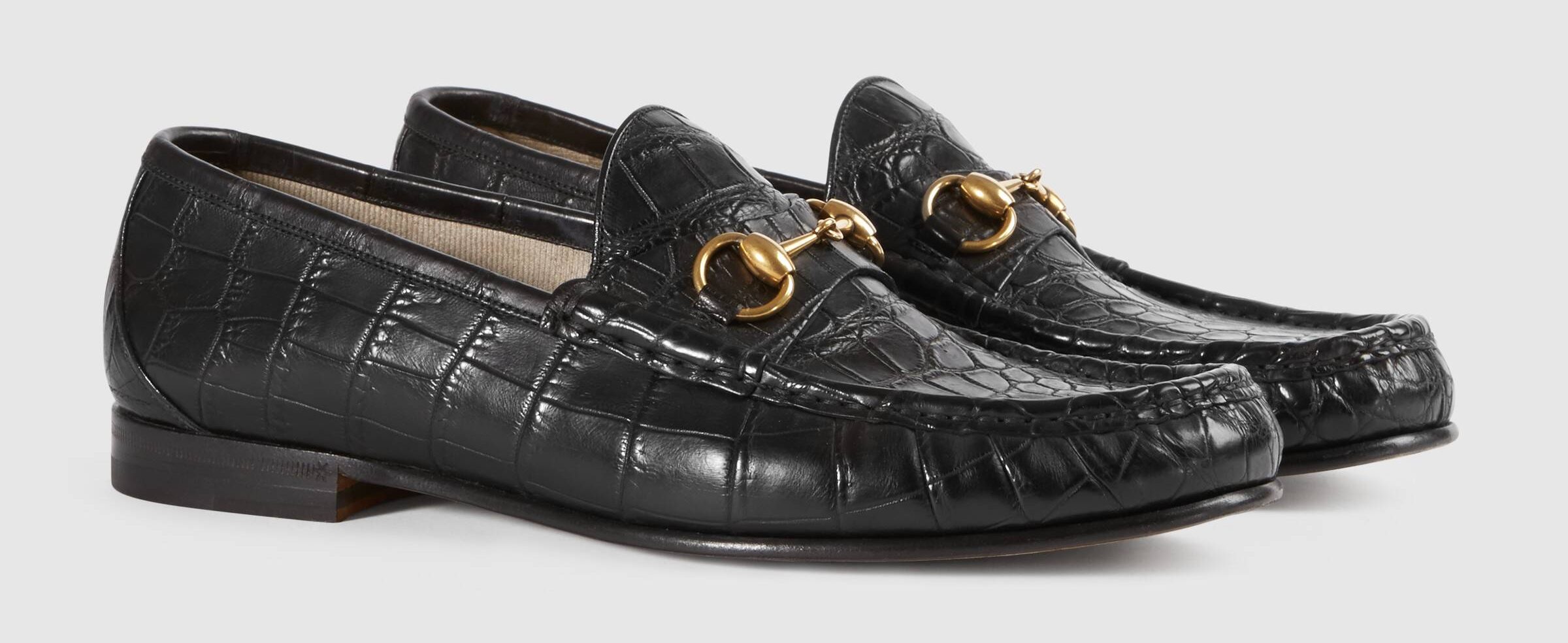

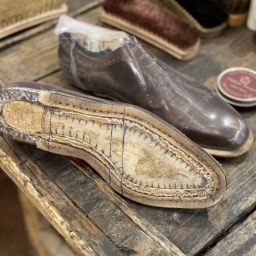



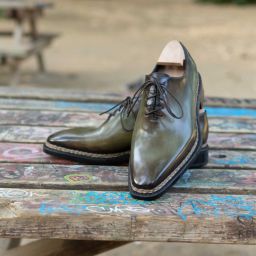






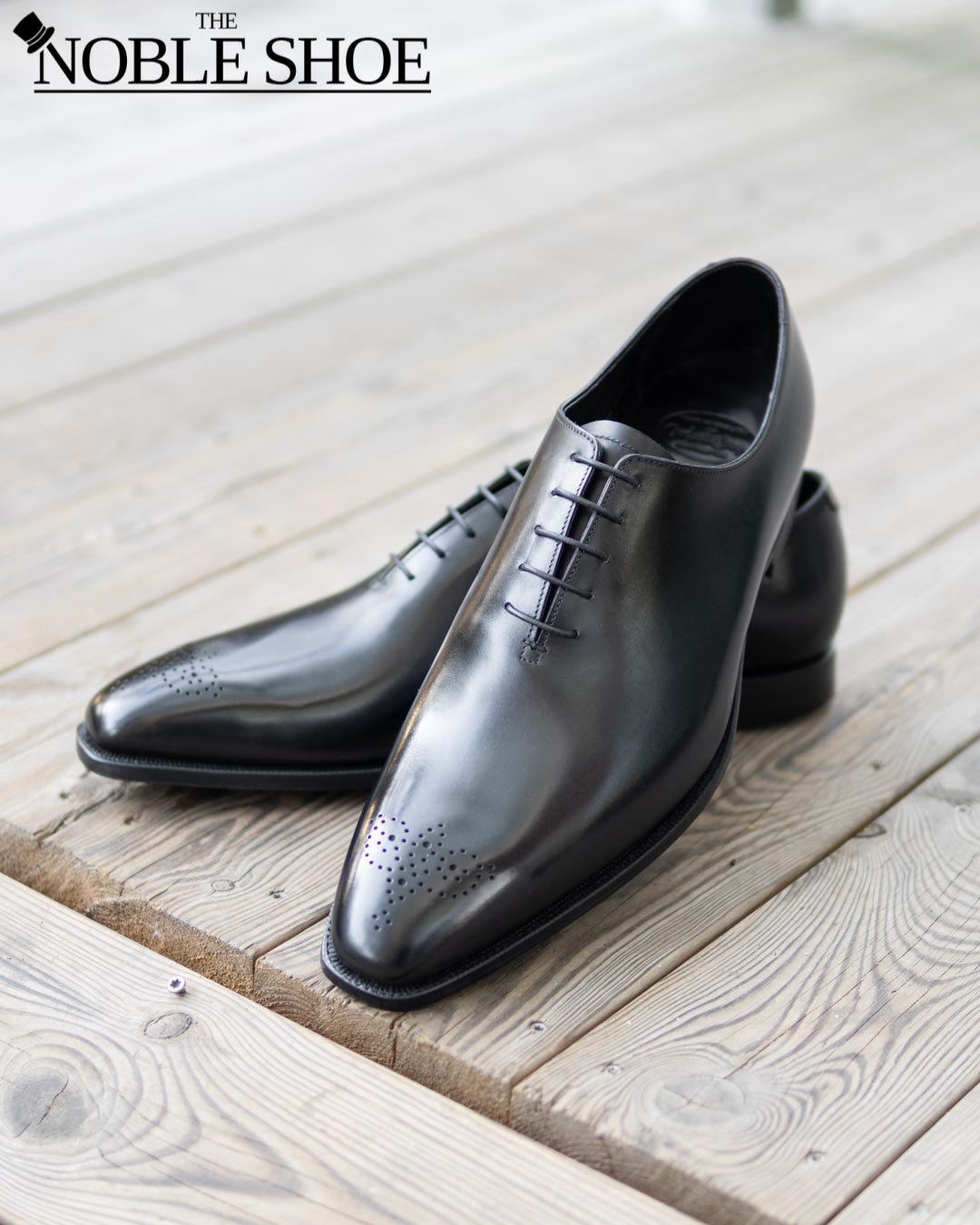
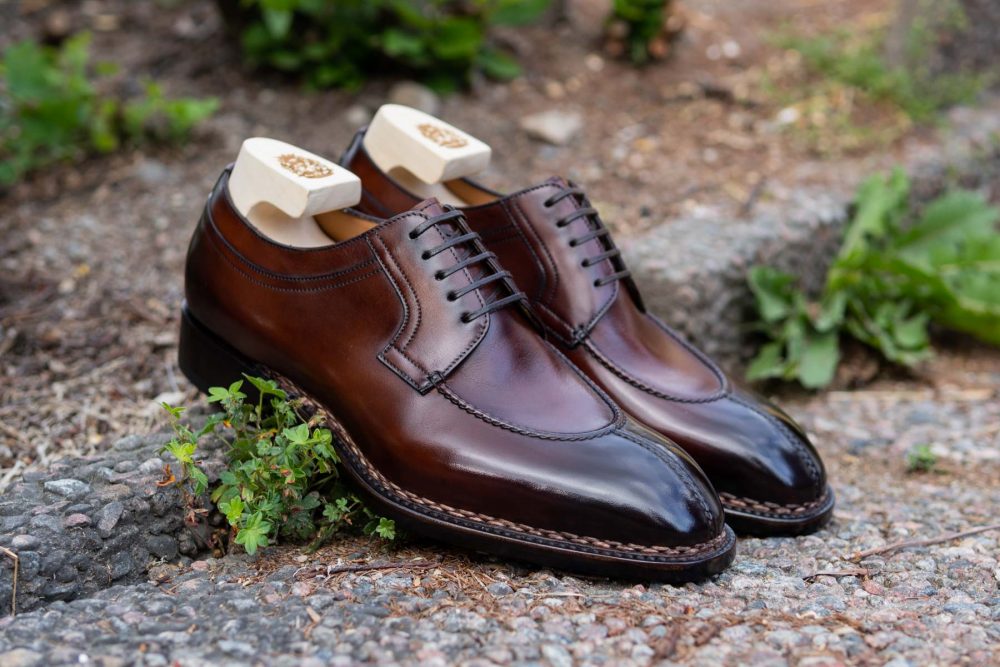

While in Budapest, last weekend, and while looking for the Vass shoes shop, I came across a shoe luthier with an extensive selection of different hides (Attila was the name, look for it). Sting ray, shark, eel and salmon among others!
To be honest I don’t think I would ever choose for such exquisite leathers, Shell Cordovan is my limit (also financially!).
I will definitely look for it. Always great to find new shops and unique designs.
I am not really a fan of exotic leathers (though alligator has been slowly growing on me) so I think regular shell and calf are what I will stick with for now!
Tip of the hat for the conclusive breakdown on shoes leather types and history.
BRAVO and thank you Kostas.
Thank you very much for your kind words Georges! Glad if it helped even just a bit!!
Thank you so much for such informative research! I sell leather shoes with great passion and will use this information to educate my customers. Makes my day when people leave with a great leather shoe to accommodate their lifestyle……again thank you! Will also pass along your name and site!
Thank you very much sir! I feel the same as you. I sell shoes as my other business. It is a great feeling and very important to educate people!
Glad to have you here!
Curious if anyone, maybe the author, knows what the camel boots in number 17 are? They look great.
Hi Ben!
It has been a while unfortunately and I am not sure where I encountered the leather!
Sea Turtle?
I mean they already make glasses out of the poor animal!
Good to have a great information in brief about all these kinds. Thank You.
You are very welcome!
I see you describe the pig leather as the pecari one.
But navigating around the web I see some Chinese brands using supposedly “pig leather” for the internal lining of their shoes, and I strongly doubt it’s pecari…
Give a look here for instance: https://www.aliexpress.com/item/32800939661.html
What’s that thing? Is it ok?
Thanks, Alex
Hi Alex,
thank you for your comment! I hope you found the guide useful. The insole on your link is pig split leather. Which is probably scraps of leather of very low quality put together. It does not refer to the inner lining which is probably low quality cow skin. Peccary leather has a very distinctive look and is not something used in such low quality/price shoes. If your budget is really that low, as long as you are aware of what you are buying it is ok. Otherwise I would recommend you to look for second hand shoes on ebay or a brand like Meermin.
Best,
Kostas
Thanks Kostas, no, I can go for better shoes (even tho not the 250$ ones): I live in Italy and even not the supa-dupa shoes are decent enough if you get a “made in Italy” decent brand, mine is mainly curiosity 🙂 Eventually the problem is to be able to recognize the good leather when getting those shoes as they are all “real leather” and now we both know that this doesn’t really say nothing (well, only that it isn’t PU plastic).
And of course I found your tutorial great! I know some of those exotic ones (toad, lizard, crocodile, chicken, elephant, turkey and stingray) but mainly for my watch straps 🙂
That’s great! Generally leather quality is hard to judge as you near to wear the shoes a bit before you see what is under, but low quality leather tends to crack and lose shape really quickly. Generally anything under Meermin prices is going to be average to bad leather in my opinion!
I would advise you looking at Velasca Milano maybe!
Great post.Thank you so much for such an informative research and article..Keep up the good work and will definitely share the reference of the site to everyone.
You are welcome and thank you for your nice comments!
Thank you very much for these lesson.
I loved Ostrich now!
Hello!
Glad to enjoy my guide! It took me a long time to write!
As for the waterproofness, no shoe is really completely waterproof. Ostrich leather is said to have very nice water resistance however, but it always depends on the quality and the construction of the shoe. It is a very unique leather!
Does Ostrich leather water resistance?
Hello Kostas,
I assume that these leathers apply to women’s shoes as well (I don’t see any pictures, hence the question).
Hi Sheldon! A lot of your average women’s shoes are from low quality leather but the same rules apply here! It is much more difficult to find women’s Goodyear welted shoes though. But more expensive and designer ones should use higher quality leather. Construction wise if you look at women’s welted shoes there’s no difference apart from the fact they usually women have narrower feet so the lasts are narrower!
This article was very informative! Thank you so much Kostas 🙂
I am not a footwear designer (YET!) but have recently been researching and creating my designs; so understanding materials and their characteristics is super important at this stage for me specially with the current situation where I am unable to visit suppliers. I can’t express how much your article has helped. Amazing work.
Hello!
Glad to hear and good luck with your adventures! Consider sharing the article to inspire others! Let me know of your progress!
Best,
Kostas
Your article is very informative especially for those who are experiencing foot pains for a wide range of reasons, such as: but not limited to arthritis, bunions, bursitis, diabetes, gout, ingrown toenails, tumors ( see links below for a partial list )
I wish that you could make a comprehensive list of leather with the following index
1- Softness index
2- Breathability index
3-Waterproof index and other pertinent info a potential shoe buyer would like to know.
Mayo Clinic causes of foot pain https://www.mayoclinic.org/symptoms/foot-pain/basics/causes/sym-20050792
Thanks Pierre,
Glad you like the article. I put a lot of effort and time into it last year. If I finally have the time I will try to write such an article 🙂
Very informative indeed.. I can think of only one omission, and it only had a very short life span: Cowboy boots made from bullfrog leather.. That was back in the 1980s, when Urban Cowboy with John Travolta started a major cowboy boot boom in the US. Thankfully, this pointless atrocity vanished again in no time.
I own several exotic boots, including ostrich, alligator, and anteater (top-shelf Luccheses, purchased in the late 90s, before the animal was on the endangered species list. They are probably worth a fortune today.)
Eel, stingray and shark have also been around for a long time, so I pretty much thought I had seen it all.
Yet, those Big Bass fish leather boots are something else. I do have a strong taste for the unusual, but these are most likely the ugliest and most disgusting cowboy boots I have ever seen. Thanks for sharing. 😉
Thanks for reading!
We could go on and on and on about exotics! Pretty much anything man can skin, he will make shoes out of them. Those fish ones are hideous ?
Great article Kostas, very in-depth!
I was looking at a pair of winter boots and the description mentions “Eldorado Leather Upper”. Have you come across this term?
Thanks,
Michelle
Hi Michelle! Thank you for reading and taking a time to comment!
I am glad you found this article helpful. I am not familiar with that “leather”. Maybe if you post a link here I can check it out for you!
Hi Michelle,
I am by no means an expert on leather such as Kostas., and I don’t even make shoes. When I have seen the term “leather upper” on shoes, it means the shoe is constructed in two parts or sections. This is common in boots and oxfords. The “upper” section is made of real leather and the bottom section is a man-made material.
this is a wonderful work sir, i am learning this very work, and i really in need of help, on cutting pattern and sawing. i appreciate sir, God bless you.
Glad you enjoy!
Excellent article about leathers. Is lizzard leather durable? Also, it will be great to have an article about shoe lasts which can vary so much in length between different lasts for the same pair of feet. In this age of internet shoe hunting finding the right last or establish the relationships between differents can save a lot of time and money.
Thank you John, I appreciate you reading all this. Feel free to share it with other enthusiasts!
It is very difficult to make an article about lasts. Length does not have that much to do with things, though some are noticeable shorter or longer than others. It depends on the width, instep, arch support really.
Some of them don’t work for flatter feet and you can spot this by the gaping in the sides of the shoe when you wear them. For some others, the foot slides in forward when walking so your toes reach the toe box, even creating some heel slip.
I do suggest checking out my other articles about “Shoe Construction” and “Types of Dress Shoes”!
Which leather is used for leather sole?
They usually either use regular cow hide or they vegetable tan it which uses no chemicals and is a natural but more difficult process
Hello,
This is so wonderful post for me and i am glad about to reaching out this informative article. Actually i was also looking for some in-depth information about leather shoes and such glad thing is for me that your article helped me a lot about those things that i actually want to know. Keep sharing like this. I am so thankful to you. Must read.
Thanks again
Kostas,
You have the best description of leathers I have read thus far. The extensive time and effort are quite obvious and greatly appreciated. I found your site while searching for a type of leather called Milano. It is offered in the Springfield Leather store, and I was looking for information on it. I haven’t found any as of this date. Although I don’t make shoes, I make numerous items from various types of leather.Thank you again, and many blessings. Mic
Hi mic,
Thanks for the kind words. Most leathers these days have some gimmicky name to sound cooler or fancier. The best way is to just contanct Springfield and ask in my opinion.
As for your other comment, the upper of the shoe is simply everything above the sole. It can be made from whatever material you want. A proper classic shoe will always have full leather and no synthetics.
[…] https://www.misiuacademy.com/types-of-shoe-leather-guide/ […]
Thanks for sharing I hope you found it useful.
Hello, Kostas,
I came across your informative article, written a while back, and it is nice that you have been keeping up the conversation.
Carp leather has also been used for making shoes. My company, Sea Leather Wear, sells this type of leather.
Hi Stanley, I am glad you found this helpful! Thank you for your commend and insight!
Thank you for such a fantastic insight . I have seen some shoe making videos where they color the shoes after it is made. What type is that leather?
Hello,
subscribe to the newsletter because in a few months I will be learning Bespoke shoemaking and I will document my journey here!
The leather they paint is called crust leather and the handpainting they do is usually called “Patina”.
Great helpful article! Thank you! If you are looking for other ideas to write about, how about how to tell fake/knockoff boots from the real McCoy?
Hi Deb, thank you for reading.
I’m sorry what are McCoy? Never heard of them.
I’m very confused.pls help me.
In my country there are some types of leather which is called
Full chrome crust leather
Full veg crust leather
What kind of leathers are they?
Are they similar to full grain?
Are these kinds of Leathers expensive or good?
Better than top-grain or genuine?
Pls help Me.
What you mention is a way of tanning the leather, not a type of leather really. The quality is as good as the tannery and each one of tem has different characteristics. Ask the local source.
Hello kostas, great sharing!
I need your opinion on New balance shoes specifically named as M990WT2. I do a lot of searching but until now i still dont have a concrete and solid answer. The shoes were told made from nubuck. My concerns is are those calfskin nubuck or pigskin nubuck? From your personal view on the visual (you can googled to see the image) and based on your experience. What is the leather made of?
Appreciate your helps kostas!
Hi Nizar,
I have no idea about sneakers, especially New Balance but honestly, no mass produced sneaker brand would use pigskin for their shoes. It will not be worth the markup for them (my opinion).
I have not seen peccary nubuck and it would be a total waist in my opinion to not use regular peccary pigskin as it has a very unique texture.
If I had to guess, it would be some kind of calf nubuck.
[…] is a classic material for boots, and it’s also one of the most durable. If you have a good pair of leather boots, […]
Types of leather very well explained. this has given me a lot of information. If you wish to buy leather shoes online you must consider Saint G Dubai.
As a beginner in shoe making business this article is awesome and of good help for me. It will help me fill among during expert discussion.
Thank you very much for reading and I’m glad it helped you.
[…] Then, stroll around your house until your soft parts stiffen in that expanded position. This is the easiest way to make your shoe wearable. This procedure can be used on leather, patented leather, and suede shoes. […]
Hello kostas! What is your insight on full grain leathers? What it is made of ?
Hi, I am not sure what you mean? Isn’t there an explanation in the article? Full grain leather is the top top layer of the leather and the best part of it.
[…] Table of Contents show […]
[…] Misiu Academy – Types of Shoe Leather […]
Hi,
I was looking for information on camel leather. It’s not true
“The animal first needs to die from natural causes and is mostly present in Africa and some parts of Asia. An important part of everyday life in those areas, Camels are valuable to the locals!”
Here in Australia they are feral and the population is growing, and they need to culled at large rates. It would seem natural to use the hides.
Hi, the article is a little older now and some sources might need updating. I was not aware of that fact and generally it’s hard to find info when you search online!
Hello Kostas.
I have a question about comparing Box calf with suede; if you have two identical shoes (size, last and so on) in those materials, is it normal that the suede one feels more loose on the foot and the Box calf more tight?
Thanks for your advice!
Niko
Hi Niko, from lasting suede I saw it’s much easier, pliable and stretchy. I’d expect box calf to be tighter in a sense yes.
[…] from the underside of the animal’s skin, which makes it softer and more pliable than other types of leather. This makes it a good choice for shoes in the summertime, as it will be more comfortable to wear […]
The footwear here is great it gives you a stylish look and a leather jacket can make your over all look better.
[…] That is something that Air Jordans are aware of! They use premium leather uppers and full-grain calfskin in the construction of their shoes. The shoes are more modern and durable than other sneakers since […]
[…] brainstorming about shoe leathers a few weeks ago, I started thinking about which part is more important in a good pair of shoes. In […]
Nice to have comprehensive knowledge about all of these types in a simple way. Thank you.
Thank you!
[…] interesting is that the type of leather somehow overruns the formality of the shoe’s style. For example, patent leather derby shoes […]
[…] to your ultimate guide on types of leather shoes! We’ll explore the diverse world of men’s dress shoes, learn about different leathers, and even […]
[…] That is something that Air Jordans are aware of! They use premium leather uppers and full-grain calfskin in the construction of their shoes. The shoes are more modern and durable than other sneakers […]